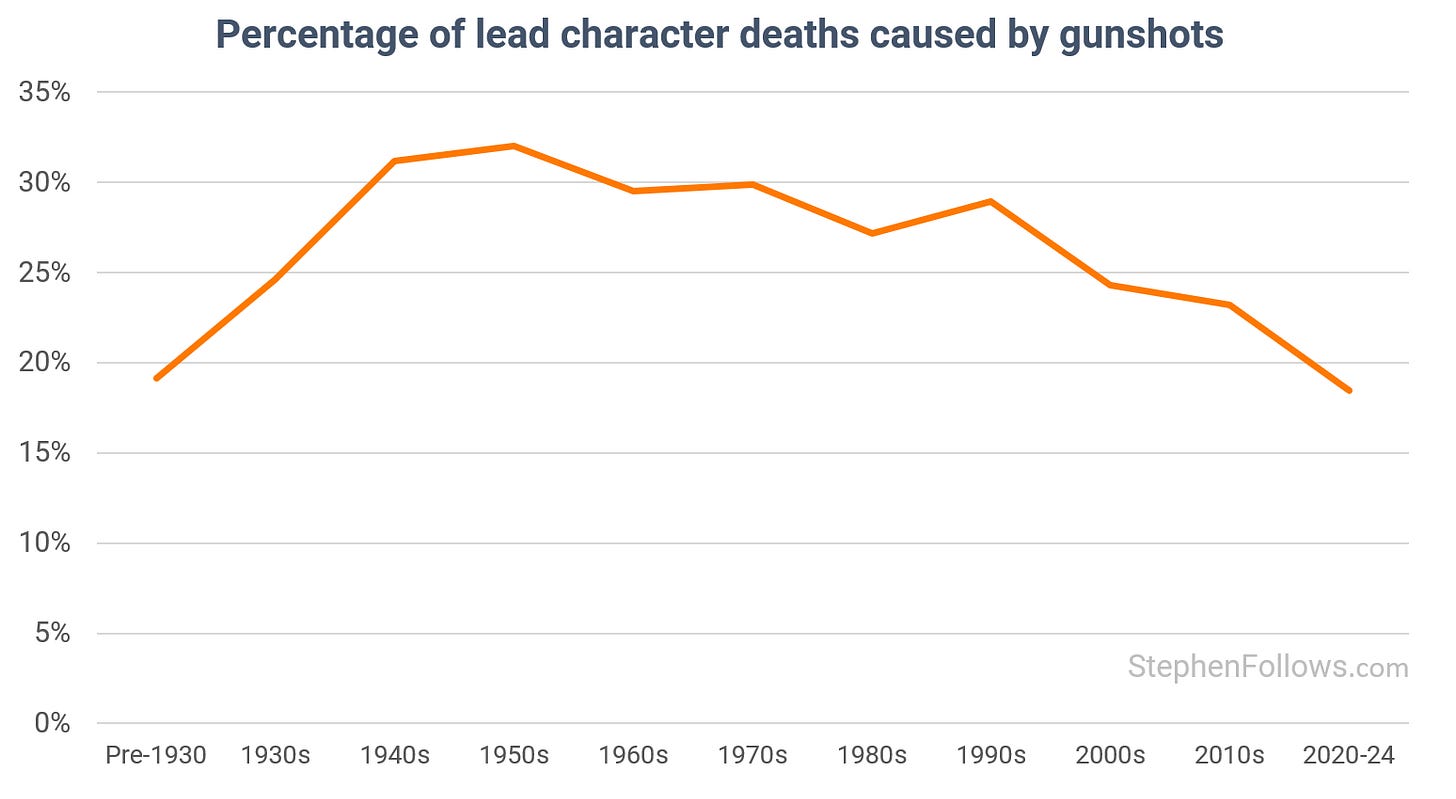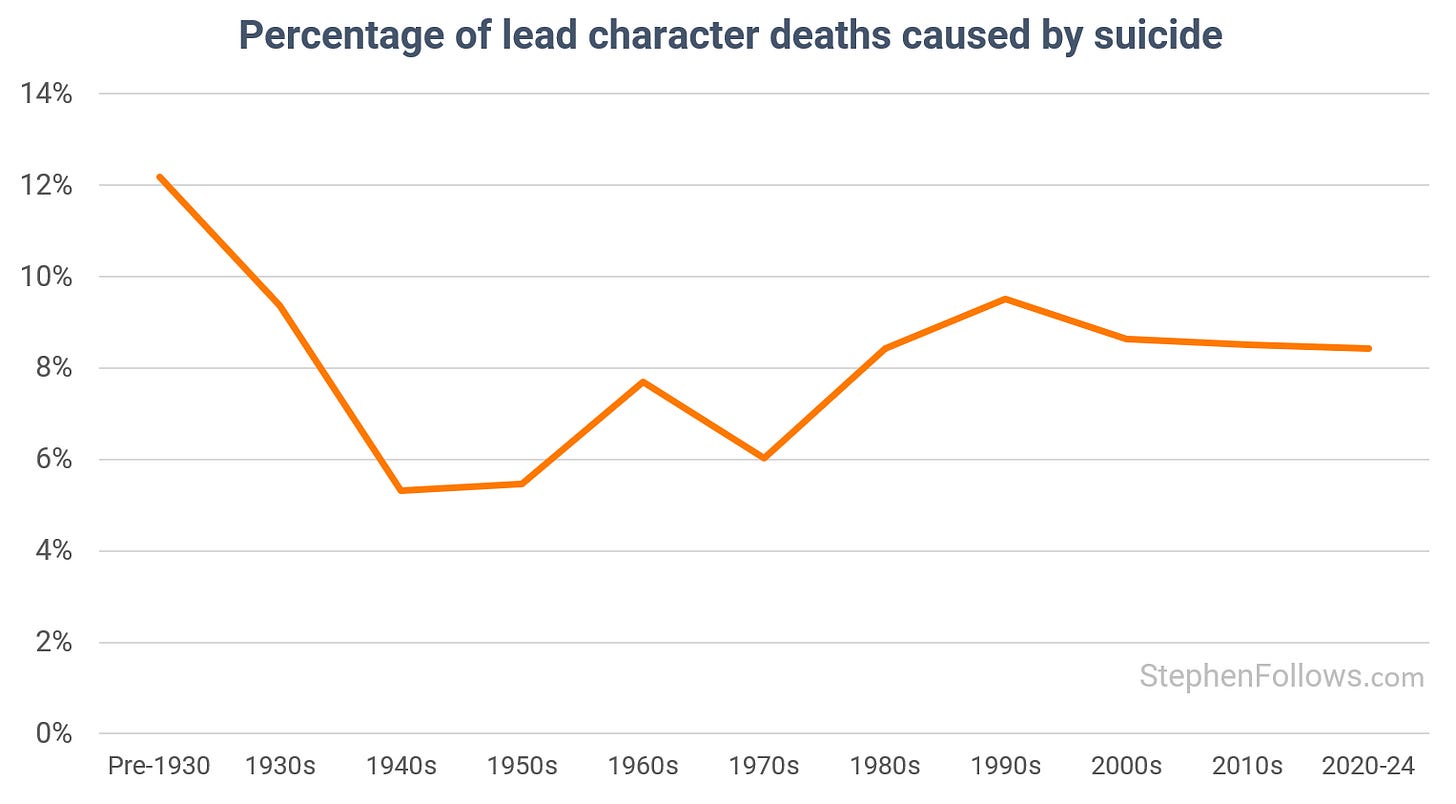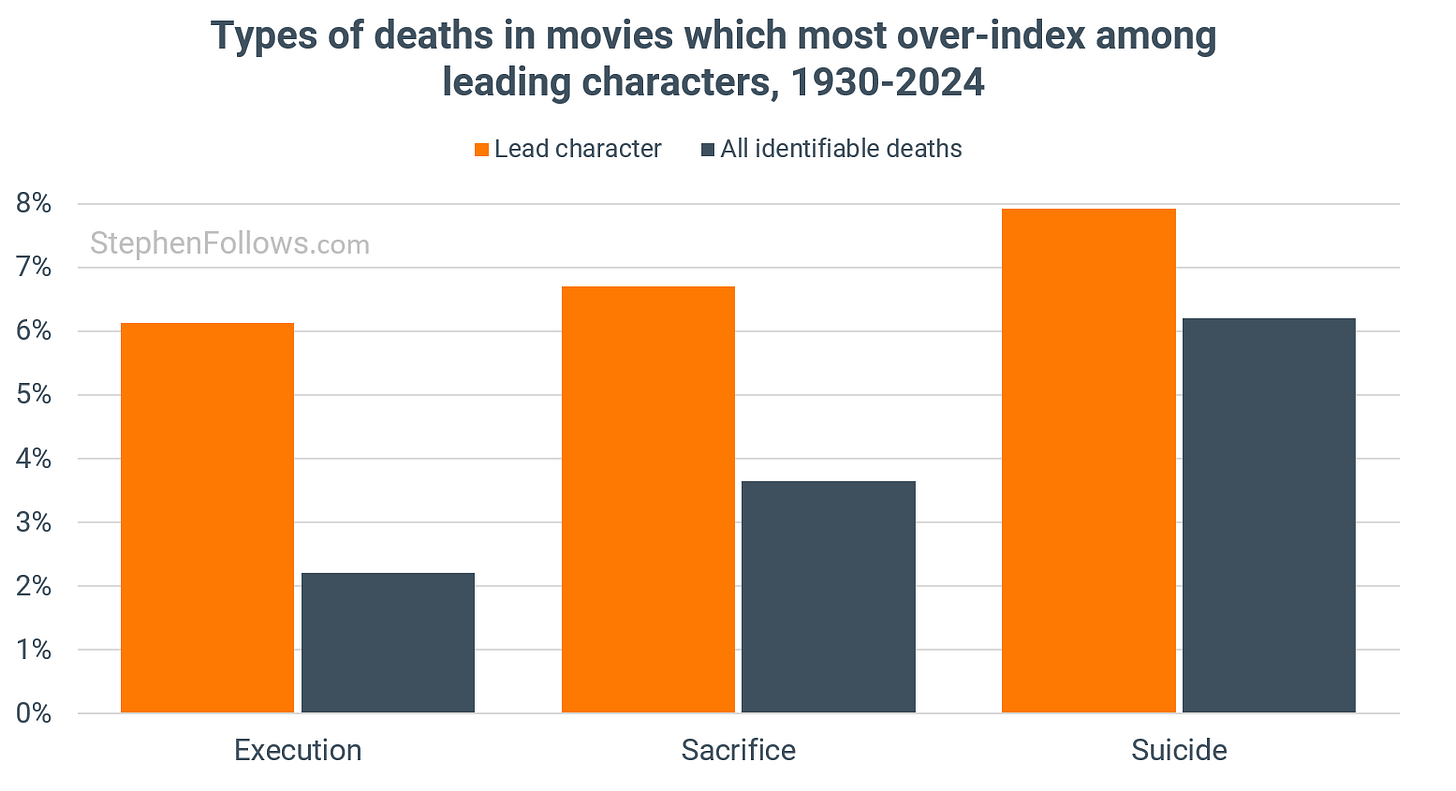How often do lead characters die in movies?
I logged the fates of 27,000+ lead characters to uncover how death on screen has shifted by genre, decade, and cause.
When a lead character dies, it often serves as the emotional or thematic climax of the movie. Their death may be redemptive (Gladiator), shocking (Psycho), inevitable (Titanic), symbolic (Children of Men), or just a bit pretentious (American Beauty).
I tracked the fates of the leading characters in 27,268 movies to find out how often the main character dies before the credits roll.
The result is a data-driven view of one of the most enduring decisions a storyteller can make. It also shows what kinds of stories Hollywood thinks are worth telling, and how that’s changed over time.
How often does the hero(ine) die?
Across the full dataset, 15.9% of lead characters die before the end of the film. That’s roughly one in six. But this figure hides major variations by time, genre, and story type.
Lead characters were far more likely to die in the 1960s and 1970s than they are today. Across the 1970s, almost one in three protagonists died by the end of the film. That rate has steadily declined since.
The drop has been particularly sharp since 2010. In the last five years, the share of lead characters who die has averaged just 17%. This is one of the lowest rates in almost a century of film history.
Death by genre
Genre plays a role in how much the death "matters." In comedies or action blockbusters, deaths are rare and often played for shock or spectacle. In drama, war, or historical films, they are central. A romantic tragedy almost demands it.
In addition to narrative significance, we also see significant differences between genres in terms of how often death occurs. In fact, the top genres are more than nine times as deadly as the safest ones.
At the top of the list are history and biography films, where the lead dies in 28.7% and 28.5% of cases. That’s unsurprising, given how many of these films portray real people whose deaths are part of the story. Braveheart, Selena, Amadeus, and Malcolm X all end with the lead’s death.
War films, westerns, and horror also show high death rates for their protagonists. War films, in particular, often use the lead’s death to underline the futility or cost of conflict, such as Saving Private Ryan, Gallipoli, or 1917.
At the other end of the scale, just 3.1% of animated and family film leads die. Titles like Frozen, Finding Nemo, or Despicable Me put their heroes through peril but nearly always let them survive. When animated characters do die, it tends to be symbolic, offscreen or quickly reversed, such as in The Lion King or Big Hero 6.
Health and Safety advice for movie leads
The most frequent cause of death for lead characters is being shot, accounting for 26.6% of all on-screen demises. This includes everything from dramatic assassinations like The Godfather Part III and The Assassination of Jesse James to chaotic shootouts in Scarface or Bonnie and Clyde.
Natural causes come next at 9.0%, and they are typically found in dramas and biopics such as The Father, Philadelphia, or Still Alice.
Suicide is involved in 7.9% of lead character deaths. Sometimes, suicide is central to the story (Dead Poets Society, Leaving Las Vegas), and other times, it is a sudden final act (The Hours, Thelma & Louise).
Supernatural deaths have been on the rise, no doubt linked to the growing ubiquity of horror films and horror tropes in mainstream cinemas (read more on that here: We're in a golden era for horror movies).
The most narratively powerful deaths tend to fall into a few categories. Sacrifice, where the protagonist dies to save others, often lands hardest. So does suicide, especially when tied to inner conflict (Dead Poets Society, The Hours). Executions and murder can provoke outrage or grief, while natural causes or accidents are less common unless the film is about illness or aging (Amour, The Fault in Our Stars).
Dying to be different
To uncover what makes a hero’s death different, I also tracked all the ways other identifiable characters die. These other characters will also be ‘leads’ of a sort, as they would only be counted if their death was mentioned in the plot summary on Wikipedia.
Gunshot is the largest category of deaths, no matter if you're a leading man/woman (26.6% of those who die met their fate this way) or a supporting sidekick (27.1%).
However, suicide and sacrifice are both far more common among lead characters. Together they account for 14.6% of lead deaths, compared to just 5.8% across all identifiable deaths. These are often dramatic narrative choices that align with character arcs or moral conclusions, such as in Gran Torino, Armageddon, or A Star Is Born.
Executions are almost three times more likely to befall leads than supporting characters. Movies such as Dead Man Walking or Braveheart place their protagonists at the centre of moral or political acts of punishment.
Conversely, deaths by physical force or cutting are underrepresented among leads. These are more often seen in chaotic crowd scenes or genre set-pieces where individual character identity matters less. In ensemble-heavy action films or war movies, unnamed characters may die by the dozen while the lead survives or gets a more narratively satisfying exit.
Notes
Today’s research was based on 27,268 feature films released between 1930 and 2024. Data came from Wikipedia, OMDb, and IMDb. I focused on films with meaningful plot summaries on Wikipedia. That said, the level of plot detail provided does vary between titles.
Epilogue
I’m fascinated by the point of inflection that the 1970s appear to be. The data we’ve seen today reveals that the 1970s were the most dangerous time to be a movie hero.
This mirrors an unconnected trend I saw a few weeks ago when I examined the amount of dialogue in movies. The 1970s were the quietest period in modern cinema, with dialogue use at its lowest and the longest gaps between spoken lines.
That space, both literal and narrative, fed into the ambiguity, introspection, and moral uncertainty that defined so many films of the time.
Add to that the real chance that a character you had been following might die, on top of the anti-heroes, fatalism, and downbeat endings already reflecting wider cultural and political disillusionment.
Film scholars have been saying this for decades, but it’s satisfying to see the data back it up too.











"Lead characters were far more likely to die in the 1960s and 1970s than they are today. Across the 1970s, almost one in three protagonists died by the end of the film. That rate has steadily declined since."
Similarly fascinated by this. audiences and studios have grown weak. thank you for this.
What do you reckon happens to Tom Cruise in mission impossible?